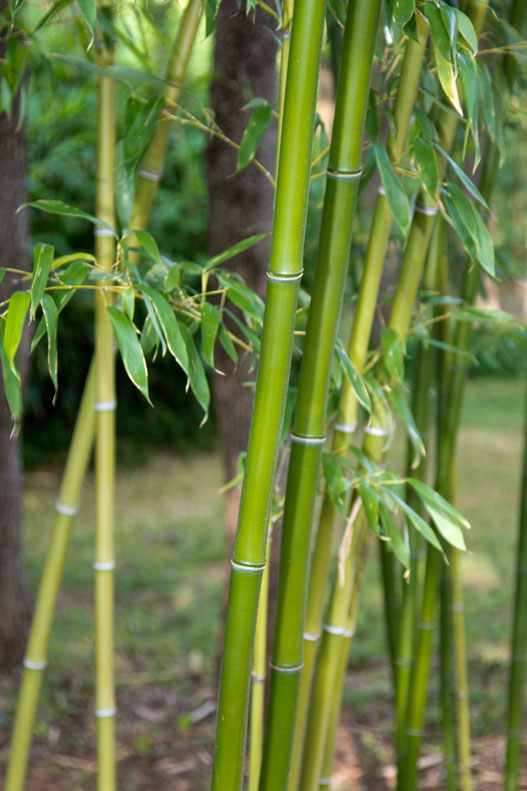
PLANTING, GROWING,
and CONTROLLING
Bamboo is easy to take care of:
Most of the care will be necessary for the first year after planting with minimal maintenance necessary after that.
When you first bring home your bamboo:
1. Dig a hole about twice the size of the container the plant comes in.
2. Loosen the root ball to give the root system a chance to grow outwards.
3. Mix organic matter (bamboo loves all types of manure) with the
excavated soil.
4. Place the plant in the hole so that the soil level matches the top of the root ball. Fill in the hole with the mixed soil and press lightly.
5. Build a donut shaped depression around the plant and water deeply. It is very important that the bamboo does not dry out during the first year after it has been planted. Signs of drying are observable as the bamboo leaves roll up like cigarette paper and appear very narrow looking. This is one of the reasons it is better to plant the new bamboo in the fall -- winter rains will prevent it from drying out. After the initial soaking be sure and give it some intermittent soaks (if the rain is uncooperative.) It thrives best with intermittent feedings of manure. You can also apply a high nitrogen fertilizer in the spring when the new shoots develop, a low nitrogen fertilizer in the fall, for increased rhizome (root system) activity.
HOW BAMBOO GROWS
It takes 3 to 5 years to establish a grove of full size bamboo shoots. Once a year-old plant is transplanted it will not grow anymore, but each Spring the rhizomes underground will put up new shoots. The first Spring after planting it will put up a few small shoots. The second Spring the new shoots will be a little bigger and more in quantity. The third Spring the new shoots will be about the size of the original plant. After that, each Spring will produce full size ( or close to full size) shoots for that particular variety. When the shoots come up each Spring it will only take 6-8 weeks for them to grow to their full height after the first 3 years. If they are contained in a small area, they probably will not reach their full maximum growth. But if not contained, they will spread in all directions and into flower beds, gardens, under sidewalks and into your neighbors yards. So if you have lots of room and don‘t care where they go, let them roam and you will be rewarded with a bamboo forest. In a small area you might want to chose a variety that can get much larger than you want, but if you contain them, they will be smaller.
MAINTENANCE AND CONTROL
It is not difficult to control bamboo.
There are many effective ways to do so:
Running Bamboos are spreaders and need room to grow but can be curbed to the desired growing area. This is most easily done in the plant's initial stages of growth by simply cutting off the new shoots as they appear where no growth activity is desired. A root barrier can be established by trenching a perimeter around where the plant is to be contained, and then placing a vertical barrier made from 20-24 inch aluminum flashing or (even simpler) hi density polyethylene plastic material. Another method is by filling the trench with concrete. Some growers plant the bamboo in a raised bed with two vertical sides. The relatively shallow growing rhizomes (seldom below 1 1/2 feet spread horizontally and will therefore not be able to extend further. A simple way of curbing the spread of bamboo is also to drip irrigate the plant at the middle only as the rhizomes (roots) will look for water sources and will prefer to stay where it is humid. The bamboo stems (culms) are one of the main attributes of the plant and should be exposed for effect. This is easily accomplished by thinning them out -- mainly getting rid of the thin and unsightly ones. The culms are also more visible when the lower branches are cut out at the base. This is mainly done with the large diameter bamboo (timber). In the smaller and dwarf varieties, the main attraction is seen in the swaying culms and various attractive variegated (striped) leaves. Many special effects can be created. The enjoyment in bamboo can be never-ending, from stunning visual effects to many practical uses, (privacy, shelter for tender plants, windbreaks, ground and slope stabilization, to name a few.)
Plants with their oxygen creating ability also help to improve our well being, so important in this age of pollution. And we need all the help we can get.
Have fun with your bamboo and if you have any questions or problems (sorry -- just bamboo related) please let us know as we are here to help you.
HAPPY BAMBOOING!
Sharon Hahn
Bamboo Satori
Guthrie, Oklahoma